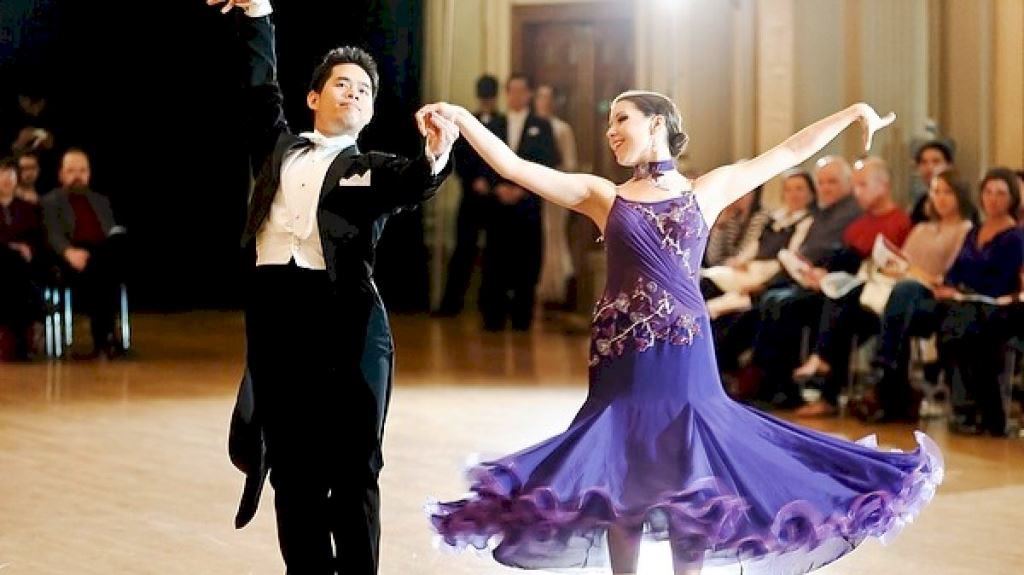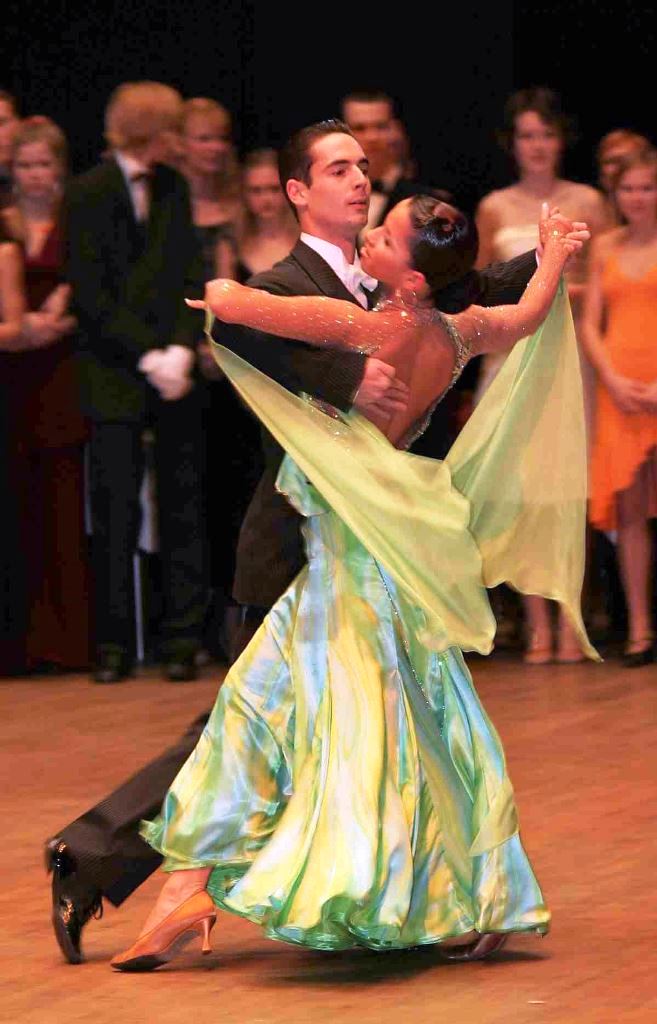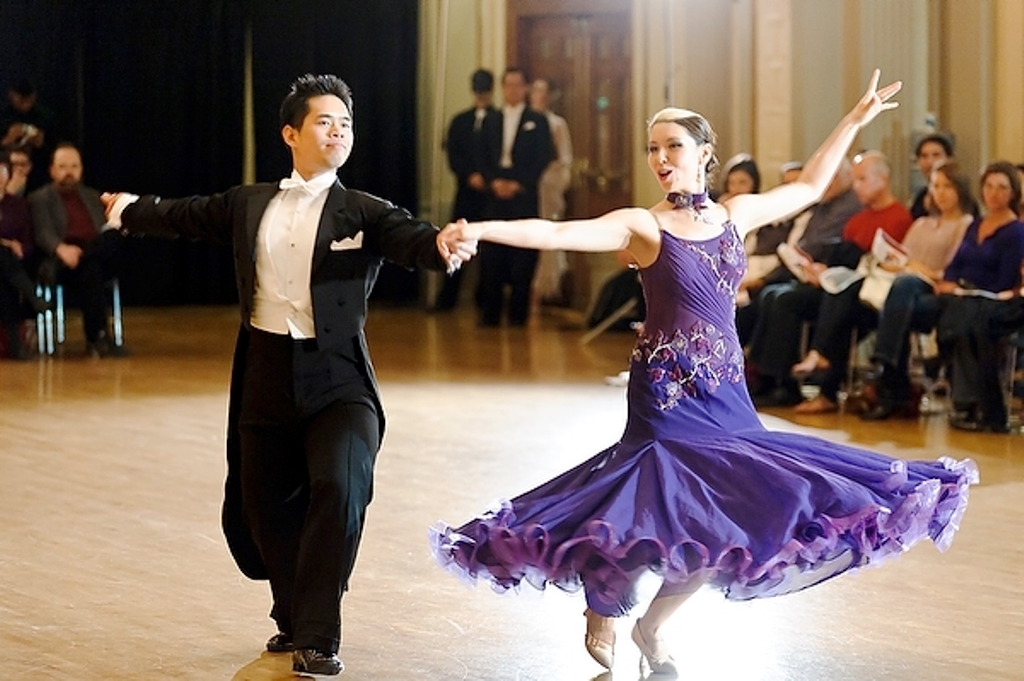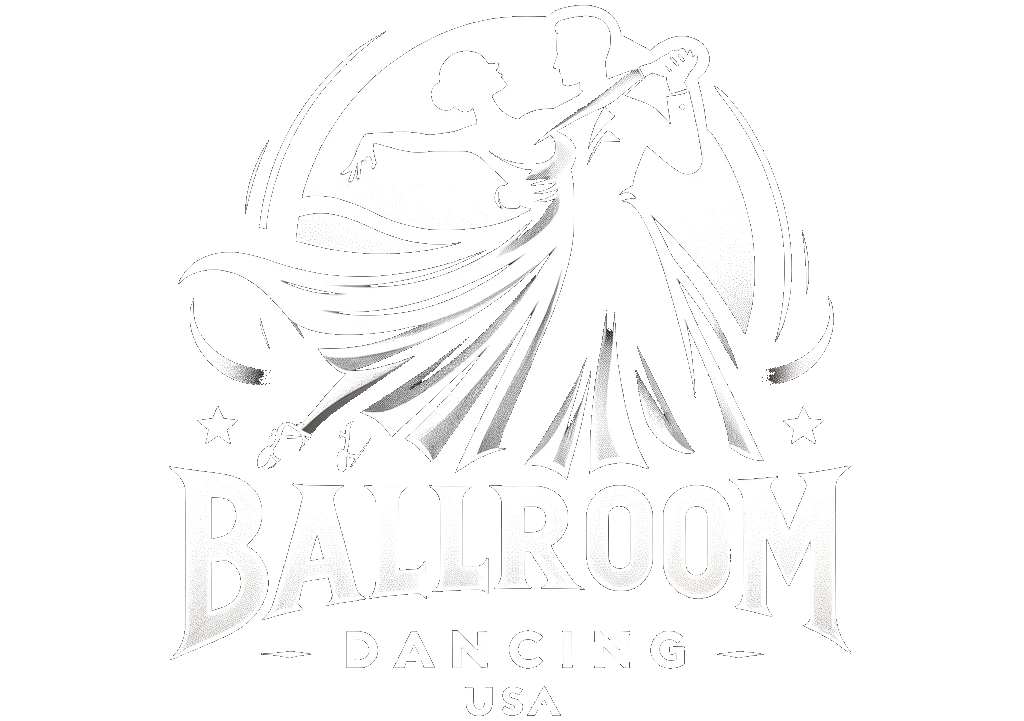
1. Introduction to Ballroom Dancing
Introduction to Ballroom Dancing
Ballroom dancing is a form of partner dancing that has been enjoyed by people around the world for centuries. It is a social activity that involves two people dancing together in a coordinated, choreographed, and graceful manner.
In the United States, ballroom dancing has become increasingly popular over the past few decades, with more and more people taking up the activity for fun, fitness, and even competition. The beauty of ballroom dancing lies in its variety; there are many different genres of ballroom dance, each with its own unique style and flavor.
The Waltz
The Waltz is the oldest and most traditional of the ballroom dances. It is a slow and graceful dance that is usually danced in 3/4 time. The Waltz is characterized by smooth, sweeping turns and a continuous, flowing movement.
The Foxtrot
The Foxtrot is a smooth, progressive dance that is danced in 4/4 time. It is characterized by quick steps and gliding movements. The Foxtrot is a great dance for beginners, as it is easy to learn and has a very relaxed feel.
The Tango
The Tango is a passionate and dramatic dance that is danced in 2/4 time. It is characterized by sharp, staccato steps and dramatic pauses. The Tango is a challenging dance that requires a great deal of skill and precision.
2. Different Genres of Ballroom Dance
Different Genres of Ballroom Dance
Ballroom dancing is a wide-ranging activity that encompasses many different styles. From traditional waltzes to the energetic tango, there is a ballroom dance for everyone. Let’s explore the different genres of ballroom dance available in the USA.
Waltz
The waltz is the oldest and most popular of the ballroom dances. It is a smooth, elegant dance that is characterized by its graceful, sweeping movements. It is a slow, romantic dance that is perfect for a romantic evening.
Foxtrot
The foxtrot is a light, lively dance that is characterized by its quick, syncopated steps. It is a more upbeat version of the waltz, and is great for getting people on the dance floor.
Tango
The tango is a passionate, intense dance that is characterized by its sharp, staccato movements. It is a more complex dance than the waltz or foxtrot, and is often seen at more formal events.
Viennese Waltz
The Viennese waltz is a faster version of the traditional waltz, and is characterized by its rapid, spinning movements. It is a great way to show off your skill and agility on the dance floor.
Swing
Swing is a fun, energetic dance that is characterized by its bouncy, upbeat movements. It is great for getting people up and dancing, and is perfect for a lively party.
Cha Cha
The cha cha is a Latin-inspired dance that is characterized by its quick, syncopated steps. It is a great way to show off your Latin flair, and is perfect for a night of fun.
Salsa
Salsa is a Latin-inspired dance that is characterized by its fast, energetic steps. It is a great way to show off your Latin moves, and is perfect for a night of dancing.
Rumba
The rumba is a Latin-inspired dance that is characterized by its slow, sensual movements. It is a great way to show off your romantic side, and is perfect for a romantic evening.
3. Waltz – History and Technique
Waltz – History and Technique
The Waltz is one of the oldest and most popular forms of ballroom dance. It originated in the late 18th century in Austria and Germany, and has since spread throughout the world. The Waltz is a smooth, progressive dance that is characterized by a rise and fall action and a continuous turn to the left.
History
The Waltz was originally viewed as a scandalous dance, as it involved couples dancing close together, which was considered inappropriate during that time period. Despite this, it quickly gained popularity and was soon adopted by high society. By the 19th century, the Waltz had become a popular ballroom dance in Europe and the United States.
Technique
The Waltz is a three-beat dance, meaning that it is danced to music that has three beats per measure. The basic step consists of three steps taken in a circular motion, with each step taking one beat of music. The rise and fall action is created by pushing off the ground and then sinking back down. The continuous turn is created by taking small steps to the left as the couple moves around the dance floor.
The Waltz is a partner dance, with the man leading and the woman following. The man should lead with his body and the woman should follow with her body, creating a connection between the two partners. The Waltz is often danced with a graceful, romantic style, with the couple moving in harmony with the music.
4. Foxtrot – History and Technique
Foxtrot – History and Technique
The Foxtrot is a smooth, progressive ballroom dance that developed in the early twentieth century in the United States. It is believed to have been invented by vaudeville performer Harry Fox, who was inspired by the trotting of horses. The Foxtrot is a fast-paced dance that is characterized by its quick steps and quick turns.
History
The Foxtrot is believed to have originated in the early 1900s in the United States. It was created by vaudeville performer Harry Fox, who was inspired by the trotting of horses. Fox’s dance was initially called the “Fox’s Trot” and was performed to ragtime music. The dance quickly gained popularity and by 1914, it was being performed in ballrooms across the country.
Technique
The Foxtrot is a smooth, progressive dance that is characterized by its quick steps and quick turns. The basic step is a slow-quick-quick pattern, with the first step being a slow step and the two following steps being quick steps. The steps are performed in a linear pattern and the dance is danced in a closed position. The Foxtrot also includes a variety of turns, such as the natural turn, the reverse turn, and the pivot turn.
The Foxtrot is a popular ballroom dance that is still performed in ballrooms around the world. It is a great way to practice your ballroom technique and have fun while doing it.
5. Tango – History and Technique
Tango – History and Technique
Tango is a passionate and romantic dance that originated in the late 19th century in the working-class neighborhoods of Buenos Aires, Argentina. It is known for its intricate footwork, dramatic pauses, and sensual embrace. Tango is considered one of the most popular ballroom dances due to its passionate and dramatic nature.
Origins of Tango
Tango is believed to have originated from the fusion of several different styles of dance, including the African candombe, the Cuban habanera, and the Argentine milonga. These dances were combined with the music of the gauchos, the nomadic cowboys of the Argentine pampas. The dance was brought to Europe in the early 1900s and quickly became popular.
Tango Styles
Today, there are several different styles of tango, including Argentine tango, International tango, and American tango. Argentine tango is the original style of tango, and it is characterized by its intricate footwork and passionate embrace. International tango is a more formalized version of Argentine tango, and it is often seen in competitive ballroom dancing. American tango is a more modern style of tango that is characterized by its dramatic pauses and intricate patterns.
Tango Technique
Tango is a partner dance, and it requires two people to properly execute the steps. The basic steps of the dance involve the leader and the follower moving in a counterclockwise direction around the floor. The leader leads the follower by initiating a step and then waiting for the follower to respond. The follower then responds by following the leader’s lead.
The basic steps of the tango involve the leader and the follower taking a step forward and then back, followed by a step to the side and then back. The leader and the follower can then repeat these steps in a variety of directions and patterns.
Tango also involves a number of turns and spins, as well as dramatic pauses and poses. The leader and the follower can also use various arm and hand movements to add to the overall effect.
Conclusion
Tango is a passionate and romantic dance that has been popular for over a century. It is characterized by its intricate footwork, dramatic pauses, and sensual embrace. There are several different styles of tango, including Argentine tango, International tango, and American tango. Tango is a partner dance, and it requires two people to properly execute the steps. The basic steps involve the leader and the follower moving in a counterclockwise direction around the floor, and they can also incorporate a number of turns, spins, pauses, and poses.
6. Rumba – History and Technique
Rumba – History and Technique
The Rumba is a Latin-American dance that is popular in the United States and around the world. It is a romantic dance that is often seen in ballroom competitions and social events.
Origin
The Rumba originated in Cuba in the late 19th century and is believed to be a combination of African and Spanish influences. It is a lively and passionate dance that is characterized by its syncopated rhythms and sensual movements.
Music
The Rumba is usually danced to a 4/4 time signature and has a tempo of about 28-30 measures per minute. The music is usually upbeat and often includes a combination of drums, bass, guitar, and vocals.
Technique
The basic step of the Rumba is a slow-quick-quick rhythm. The slow step is taken on the first beat of the music, followed by two quick steps. The feet should remain close to the floor and the body should be kept in a relaxed position. The arms should be held in a low, curved position and the head should be kept up and looking forward.
The Rumba also includes a variety of turns and dips. The turns are done by stepping onto the ball of the foot and turning the body in a circular motion. The dips are done by lowering the body and then raising it back up again.
Competition
The Rumba is a popular dance in ballroom competitions. It is usually danced in a closed position and is judged on technique, timing, and expression. The Rumba is often seen in competitive events such as the International Latin Dance Championships and the World DanceSport Federation.
7. Jive – History and Technique
Jive – History and Technique
Jive is a lively, energetic dance style that has roots in African American culture and is often seen in American films. It has been popular since the 1940s and is a fast-paced dance that is fun to watch and perform.
Origins
Jive is a style of swing dance that originated in the United States in the 1940s. It is a fusion of several different swing dances, including Lindy Hop, Jitterbug, and Charleston. It was popularized by African American dancers in the 1940s and 1950s and is still popular today.
Technique
Jive is danced in 4/4 time and is characterized by its fast, upbeat tempo and its energetic footwork. The basic steps involve a series of kicks, jumps, and spins, all done in quick succession. The dancer must have strong core muscles and good coordination to be able to execute the moves properly.
The dancers must also be aware of the music and the count, as the steps must be performed in time with the music. The arms are used to add to the energy of the dance, with the arms often moving in opposite directions to the feet.
Styles
Jive is often seen in American films and is usually performed in a competition style. This style of jive is very precise and requires the dancers to be in sync with each other and to perform the steps with precision.
Another popular style of jive is called “street jive”. This style is more improvisational and allows the dancers to express themselves more freely. It is often seen in clubs and parties and is usually danced to popular music.
Competitions
Jive is a popular dance in competitions and is often seen in ballroom dance competitions. The dancers must be precise and in sync with each other to be successful in competitions. The dancers must also be aware of the tempo of the music and the steps must be performed in time with the music.
Conclusion
Jive is a lively, energetic dance style that has been popular since the 1940s. It is a fusion of several different swing dances and is characterized by its fast, upbeat tempo and its energetic footwork. It is a popular dance in competitions and is often seen in American films.
8. Cha Cha – History and Technique
Cha Cha – History and Technique
The Cha Cha is a lively Latin-American dance that is full of energy and passion. It is believed to have originated in Cuba in the 1950s and was initially known as the ‘Triple Mambo’. The dance is a combination of the Cuban Mambo and the Rumba, and it was designed to be danced to a new style of Cuban music that was emerging at the time.
The Dance
The Cha Cha is a partner dance that is danced in a 4/4 time signature. The basic steps of the Cha Cha consist of three quick steps and a fourth step that is slightly slower. The steps are often referred to as “Cha Cha Cha” and the dance is often characterized by a Cuban hip motion.
The Cha Cha is danced both in a line and in a circle formation. In the line formation, couples stand side-by-side and perform the dance in unison. In the circle formation, couples form a circle and dance in a counter-clockwise direction.
Music
The Cha Cha is typically danced to Latin music, such as Mambo, Salsa, and Reggaeton. The music is often fast-paced and has an infectious rhythm that encourages dancers to move quickly and with a lot of energy.
Competition
The Cha Cha is a popular dance in the ballroom dance competition circuit. It is often seen in International Latin competitions and is judged on the quality of the steps, the musicality, and the overall performance of the couple.
Conclusion
The Cha Cha is an exciting and energetic dance that is full of passion. It is a popular dance in the ballroom dance competition circuit and is often seen in International Latin competitions. The Cha Cha is danced to Latin music and is characterized by quick and lively steps and Cuban hip motion.
9. Samba – History and Technique
Samba – History and Technique
Samba is a lively and energetic ballroom dance from Brazil, originating in the late 19th century. It is a popular social dance, often seen during Carnival celebrations, and is one of the five International Latin dances. Samba is a partner dance, with the lead taking on the role of the man and the follow taking on the role of the woman.
History
Samba originated in Brazil in the late 19th century, and has its roots in African and European cultures. It was originally danced by slaves in Brazil, and was later adopted by the upper classes as a social dance. Samba was brought to the United States during the 1940s and 1950s, and has since become a popular ballroom dance.
Technique
The basic step of the Samba is a side-to-side motion, with the feet moving in a “V” shape. The feet should be kept close to the floor, and the body should move in a relaxed manner. The lead should keep their arms slightly bent, and the follow should keep their arms slightly bent and their hands close to their body. The lead should also lead the follow with their torso, and the follow should respond to the lead’s movements. Samba is a fast-paced dance, and the steps should be done quickly and with energy.
10. Conclusion
Conclusion
The world of ballroom dance is vast and diverse, offering something for everyone. From the traditional Waltz, Foxtrot, and Tango to the more modern styles such as Salsa and West Coast Swing, there is a genre of ballroom dance for everyone. Whether you are a beginner looking to learn the basic steps or an experienced dancer looking to perfect your technique, ballroom dancing can be a great way to have fun and stay fit.
The Benefits of Ballroom Dance
Ballroom dance is not only a great way to have fun and stay active, but it also offers a number of other benefits, such as improved coordination, increased confidence, and improved social skills. Additionally, ballroom dance can be a great way to meet new people and make friends.
Finding a Dance Partner
If you are interested in getting into ballroom dancing, the first step is to find a dance partner. There are a number of ways to do this, including taking classes, attending social dances, or joining a dance club. Once you have found a partner, you can then begin to explore the different genres of ballroom dance and find the one that is right for you.
Conclusion
Ballroom dance is an enjoyable and rewarding activity that can provide a lifetime of fun and fitness. Whether you are a beginner looking to learn the basics or an experienced dancer looking to perfect your technique, ballroom dancing offers something for everyone. So why not give it a try?





